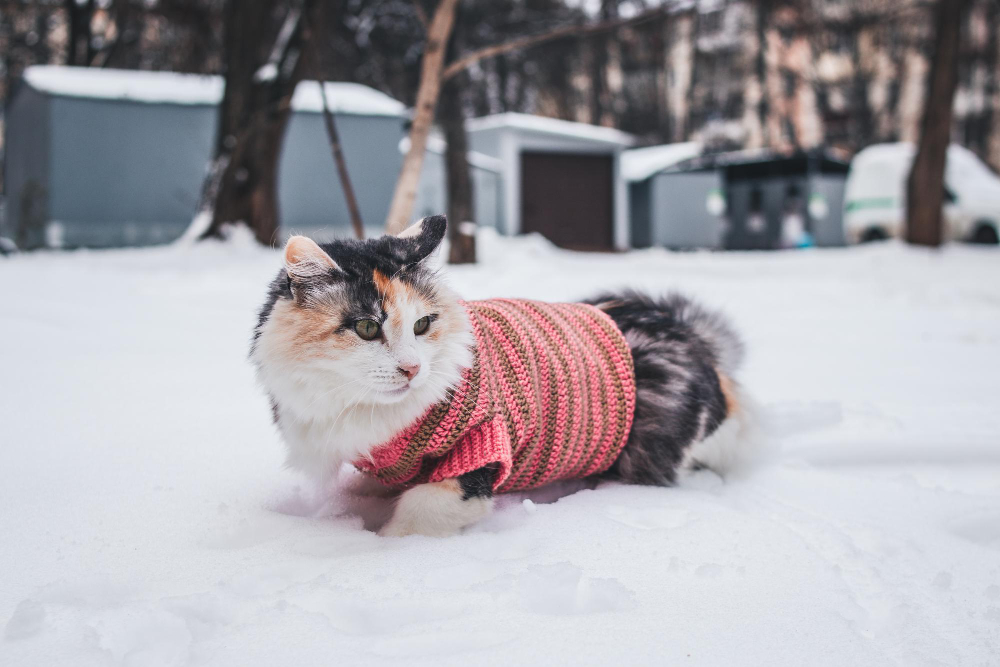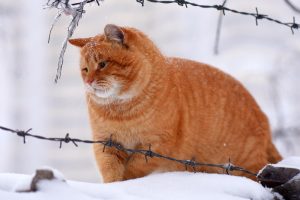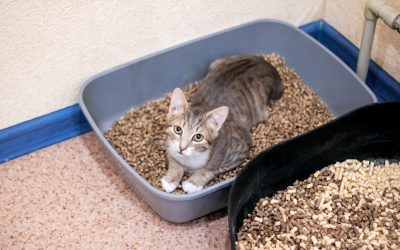Winter Wellness: Maintaining Your Cat’s Health in Cold Weather

In winter, outdoor cats conserve energy by lowering their activity levels and seeking warm, insulated spots to stay comfortable. Their survival instincts may drive them to seek warmth and explore unknown, dangerous areas for it, so it’s important to provide them with a safe, comfortable outdoor space. Outdoor cats need more calories in winter to stay warm and energetic. As their metabolism increases, they may need more frequent, high-calorie meals to replace the energy used to stay warm.
How to Build DIY Cat Shelter in Winter?
To keep outdoor cats safe in winter, give them a warm, insulated shelter. You can buy commercial cat houses, but building a DIY cat shelter can be a rewarding, cheap solution. Here’s how you can create a cozy haven for your feline friends:
Choosing the Right Location
The location of the cat shelter is crucial for its effectiveness and accessibility. Consider the following factors when selecting a spot:
- Proximity to your home: Place the shelter where you can easily monitor and maintain it.
- Protection from the elements: Pick a spot sheltered from harsh winds, rain, and snow.
- Warmth and sunlight: Position the shelter to get sun during the day. However, direct exposure should be avoided to prevent overheating.
- Visibility: Make the shelter visible to your cats. But, it should be hidden from predators and disturbances.
Materials and Tools Needed
Before you begin construction, gather the necessary materials and tools:
- Sturdy plastic or wooden container (e.g., a large storage bin or a wooden crate)
- Insulating materials (e.g., styrofoam, rigid foam boards, or fiberglass insulation)
- Waterproof materials (e.g., plastic sheeting, tarps, or roofing materials)
- Bedding materials (e.g., straw, hay, or old towels)
- Tools (e.g., saw, drill, screws, hammer, and tape measure)
Design and Construction
Your DIY cat shelter should be warm, insulated, and accessible. Here’s a basic outline:
- Choose a suitable container or crate as the base of your shelter.
- Cut out an entrance and exit hole, ensuring it’s large enough for your cats to enter and exit comfortably.
- Insulate the interior with materials like styrofoam or rigid foam boards. This will trap heat and prevent drafts.
- Use waterproof materials outside to protect the shelter from rain, snow, and moisture.
- Add a sloped or peaked roof to allow precipitation to run off and prevent water accumulation.
Insulation and Weatherproofing
To keep the shelter warm and dry, it needs good insulation and weatherproofing. Consider the following tips:
- Insulating materials with a high R-value are used to measure thermal resistance. This will maximize heat retention.
- Seal any gaps or cracks with caulking or weatherstripping to prevent drafts.
- Install a removable door or flap over the entrance to help retain heat while allowing access for your cats.
- Apply a waterproof sealant or coating to the outside to protect against moisture and humidity.
Creating a Cozy Interior
To make the shelter inviting for your outdoor cats, add these cozy touches:
- Line the floor with thick, insulating bedding materials like straw, hay, or old towels.
- Place a heated pet bed or a microwavable heating pad inside the shelter for additional warmth.
- Provide a soft, washable blanket or mat for your cats to snuggle on.
- Install a removable litter box or designate an area for your cats to use as a bathroom.
Entrance and Exit Options
The entrance and exit of the shelter should be designed with your cats’ comfort and safety in mind. Consider the following options:
- A simple rectangular opening for easy access and exit.
- A tunnel or vestibule entrance traps heat and keeps out drafts.
- Multiple exits can help in emergencies or if one exit is blocked.
Feeding and Watering Solutions
Outdoor cats require access to fresh water and food, even during winter. Here are some tips for providing sustenance:
- Use heated water bowls or install a heated dish to prevent freezing water.
- Place food and water dishes inside the shelter or in a protected area to shield them from the elements.
- Use insulated or heated feeders. They will keep food from freezing or getting too cold to eat.
- Feed your cats high-calorie, protein-rich foods. This will help them keep their energy and body heat up.
Monitoring and Maintenance
Regularly monitor and maintain the outdoor cat shelter to ensure it works well and lasts a long time. Here are some best practices:
- Check the shelter regularly for any damage or wear and tear, and make repairs as needed.
- Replace bedding materials when they look or feel damp, have a noticeable odor, or show visible dirt.
These signs indicate it’s time to change the bedding to prevent the growth of mold or bacteria. Regularly checking the bedding helps keep your pet’s environment clean and healthy.
- Clean and disinfect the shelter periodically to maintain a hygienic environment for your cats. First, remove any bedding or loose debris, then wash surfaces with warm, soapy water.
After cleaning, use a pet-safe disinfectant to kill any lingering germs. Make sure everything is completely dry before adding fresh bedding to maintain a hygienic environment for your cats. Regular cleaning helps prevent the buildup of bacteria and keeps your cats healthy.
- Monitor the shelter’s temperature. Adjust the insulation or heating as needed.
Community Involvement and Education
Caring for outdoor cats during winter can be a community effort. Consider the following ways to involve and educate others:
- Share your knowledge and experiences with neighbors or local animal welfare organizations.
- Work with community groups to build and distribute cat shelters in areas with many stray or feral cats.
- Host workshops or campaigns to raise awareness of caring for outdoor cats in winter.
Regular Brushing in Winter
Regular grooming for outdoor cats in winter keeps them healthy and comfortable. Here’s why brushing is essential and how to do it properly:
Choosing the Right Brushing Tools
The type of brush you use can greatly affect grooming. It impacts both its effectiveness and comfort. Consider the following options:
- Slicker brushes: They have fine, closely-spaced wire bristles. They are great for removing loose hair and mats.
- Deshedding tools: These specialized tools have stainless steel or rotating teeth. They help remove loose undercoat hair and reduce shedding.
- Wide-tooth combs: They are best for detangling long fur and removing debris.
Brushing Techniques for Different Coat Types
Cats have various coat types, each requiring a slightly different brushing technique. Here are some tips:
- Short-haired cats: Use a slicker brush or de-shedding tool to remove loose hair. This will reduce shedding.
- Long-haired cats: Use a wide-tooth comb to detangle any mats. Then, use a slicker brush to remove loose hair.
- Double-coated cats: Use a de-shedding tool to remove the loose undercoat. Then, use a slicker brush to smooth the top coat.
Creating a Safe Indoor Environment
Some cats thrive outdoors but need a safe, cozy home in winter. A cozy indoor space will protect your cat from winter dangers and also ensure their well-being.
Here are some tips for creating a safe indoor environment for your outdoor cat during winter:
- Designate a Warm, Quiet Space: Set up a cozy, secluded area in your home, like a spare room or a low-traffic corner. Provide soft bedding, blankets, and a heated cat bed or heating pad to keep your cat warm and comfortable.
- Provide Plenty of Enrichment: Cats can become bored and restless when confined indoors. Offer toys, scratching posts, and cat trees. They will keep your cat stimulated.
- Set Up a Litter Box: Your cat needs a clean, well-kept litter box. They may not want to go outside in the cold to relieve themselves.
- Maintain a Consistent Routine: Cats thrive on routine. So, try to keep their regular feeding, playtime, and grooming schedules as much as possible.
- Monitor for Signs of Stress: Some cats may get stressed when moving from outdoors to indoors. Watch for signs like excessive grooming, a lost appetite, or inappropriate elimination. If you’re concerned, consult your vet.
Preparing for Outdoor Adventures
Many adventurous cats still crave the outdoors. With proper prep and precautions, you can keep your cat safe and happy on winter outings.
Here are some tips for preparing for outdoor adventures with your cat:
- Invest in Appropriate Winter Clothing: Consider a warm, waterproof coat or sweater made for cats. These garments can help retain body heat and protect your cat from the elements.
- Protect Paws and Pads: Apply a paw wax or balm to your cat’s paws and pads to prevent cracking, dryness, and irritation from exposure to cold, snow, and ice. You can also consider purchasing cat booties or socks for added protection.
- Monitor Temperature and Weather: Check the forecast. Avoid taking your cat outside in extreme cold, heavy snow, or icy conditions. Limit outdoor time to brief periods and provide a warm, sheltered area for your cat to retreat to.
- Use a Secure Harness and Leash: Always use a secure harness and leash in winter, even for indoor-outdoor cats. This will prevent them from getting lost in unfamiliar, dangerous conditions.
- Pack Essentials: Bring a small carrier or insulated bag to transport your cat safely. Also, take a towel, blanket, and supplies like water and treats.
Understanding Winter Hazards
The winter season can be magical for outdoor cats. But, it also brings dangers that pet owners should know about. By knowing these dangers, you can protect your cat this winter.
Here are some common winter hazards to be mindful of:
- Antifreeze and de-icing chemicals are highly toxic to cats. Ingesting them can cause severe illness or death. Be cautious when using these products and clean up any spills immediately.
- Hypothermia and Frostbite: Prolonged exposure to the cold can cause hypothermia. It is a potentially deadly condition with a dangerously low body temperature. Frostbite, which freezes body tissues, is another risk for outdoor cats in winter.
- Shelter Hazards: Outdoor shelters that are poorly built or insulated can be risky. They may trap moisture, create drafts, or cause entrapment. Regularly inspect and maintain your cat’s shelter to ensure it provides adequate protection.
- Road Hazards: Ice, snow, and low visibility can increase the risk of accidents for outdoor cats. Consider keeping your cat indoors during periods of heavy snowfall or icy conditions.
- Predators and Territorial Conflicts: In winter, outdoor cats may meet other animals seeking food or shelter. This can lead to territorial conflicts or predator encounters.
Recognizing Hypothermia and Frostbite
As noted, hypothermia and frostbite are major risks for outdoor cats in winter. It’s crucial to recognize the signs and symptoms of these conditions. It allows for prompt intervention and potentially life-saving treatment.
Hypothermia occurs when a cat’s body temperature falls below normal. It usually results from prolonged exposure to the cold. Signs of hypothermia in cats may include:
- Shivering or trembling
- Lethargy or weakness
- Decreased heart rate and breathing
- Pale or bluish gums and skin
- Dilated pupils
- Stiffness or difficulty walking
Acting quickly is essential if you suspect your cat is suffering from hypothermia. Move them to a warm, dry area and gently wrap them in blankets or towels. Avoid rubbing or massaging their body, as this can cause further damage. Seek immediate veterinary attention, as hypothermia can be life-threatening if left untreated.
Frostbite is a condition. It occurs when skin and tissues freeze from prolonged exposure to freezing temperatures. The areas most commonly affected in cats are the ears, tail, and paws. Signs of frostbite include:
- Cold, pale, or bluish-white skin
- Swelling or blistering
- Skin that feels hard or waxy
- Lack of pain or sensation in the affected area
Preparing an Emergency Kit
An emergency kit can greatly help your outdoor cat in a crisis. It can keep your cat safe and well.
Here are some essential items to include in your outdoor cat’s emergency kit:
- Use a sturdy, insulated carrier or crate to keep your cat safe.
- Pack several clean, dry blankets or towels to help keep your cat warm and dry if it’s cold or wet outside.
- First Aid Supplies: Include basics like gauze, antiseptic wipes, scissors, and self-adhesive bandages to help treat minor injuries and wounds.
- Heating pads or hot water bottles can be invaluable, as they provide warmth and prevent hypothermia in prolonged cold exposure.
- A list of emergency vets and trusted friends’ numbers.
- Pack some of your cat’s food and bottled water if you need to feed them.
- Include a small, portable litter box and some litter to help keep your cat comfortable and clean in an emergency.
- Toys and treats can help calm your cat in stress.
Regular Health Check-ups
Regular health check-ups with your vet are vital for responsible pet ownership. This is especially true for outdoor cats in winter. These visits can catch health issues before they become serious. They help ensure your cat’s well-being and longevity.
Here are some reasons why regular health check-ups are crucial for outdoor cats in winter:
- Early Detection of Winter-Related Conditions: Veterinarians can check your cat for hypothermia, frostbite, and other winter ailments. This allows for prompt treatment and prevents complications.
- Nutritional Needs Assessment: Your vet can check your cat’s body condition. They can then adjust the diet to keep your cat energized and insulated during the cold months.
- Parasite Prevention and Treatment: Outdoor cats are more prone to parasites like fleas, ticks, and worms. Regular check-ups and preventative treatments can protect your cat’s health.
- Vaccination Updates: Outdoor cats may be more at risk of rabies and feline leukemia virus. Regular check-ups make sure your cat’s vaccinations are up-to-date. This protects against life-threatening illnesses.
- Aging cats may develop health issues like arthritis and kidney disease. They may also have dental problems. Regular vet visits can find and manage these issues early. This can improve your cat’s quality of life.
What Does Odie Pet Insurance Cover?
Pet insurance covers various veterinary expenses, providing financial protection and peace of mind for pet owners. Here are the details of the coverage options offered by Odie Pet Insurance:
Illness & Injury Plan
The Illness & Injury Plan is an all-inclusive insurance plan designed to cover a wide range of medical needs for your pet. This plan includes comprehensive coverage for various illnesses, injuries, and veterinary services. Some of the covered items include:
- Veterinary exams and consultations
- Diagnostics (e.g., X-rays, lab tests)
- Prescribed medications
- Surgeries and hospitalization
- Rehabilitation, acupuncture, or chiropractic treatments
- Medically necessary supplies
- Euthanasia and cremation
The Wellness Plan
The Wellness Plan is a monthly membership that focuses on preventive care and covers routine veterinary services.
- Provides reimbursements for routine care items such as wellness visits (exams and vaccines), testing and parasite prevention, dental cleanings and at-home dental care, vitamins, supplements, and more.
- Through Odie’s partnership with Petivity, a leader in smart pet products and proactive care, Wellness Plan members can also receive reimbursements for Petivity devices and health kits, as well as eligible Purina food and supplements.
- Total reimbursement up to $700 per year.




